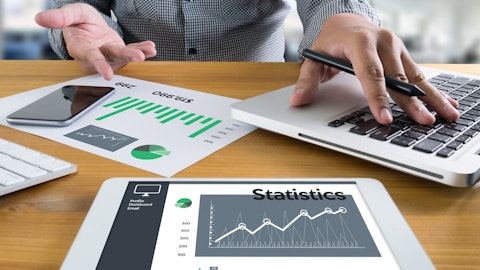SAP SE (NYSE:SAP) Q4 2023 Earnings Call Transcript January 24, 2024
SAP SE isn’t one of the 30 most popular stocks among hedge funds at the end of the third quarter (see the details here).
Operator: Ladies and gentlemen, thank you for standing by. Welcome and thank you for joining the SAP’s Fourth Quarter and Full Year 2023 results. [Operator Instructions] I would now like to turn the conference over to Anthony Coletta, Chief Investor Relations Officer. Please go ahead.
Anthony Coletta: Good morning, everyone and thank you for joining us today to discuss our Q4 and full year results for 2023. We also provide color about our 2024 outlook and 2025 ambition. With me on this call are our CEO, Christian Klein; CFO, Dominik Asam; and Scott Russell who leads Customer Success. You can find the decks implementing this call as well as our quarterly statement on our Investor Relations website. During this call, we will make forward-looking statements, which are predictions, projections or other statements about future events. These statements are based on current expectations and assumptions that are subject to risks and uncertainties that could cause actual results and outcomes to materially differ. Additional information regarding these risks and uncertainties maybe found in our filings with the Securities and Exchange Commission, including, but not limited to, the Risk Factors section of SAP’s annual report on Form 20-F for 2022.
Unless otherwise stated, all numbers on this call are non-IFRS and growth rates and percentage point changes are non-IFRS year-over-year at constant currencies. The non-IFRS financial measures we provide should not be considered as a substitute for or superior to the measures of financial performance prepared in accordance with IFRS. As a reminder, on December 18, 2023, SAP provided important updates regarding its reporting. These changes are detailed in the presentation on our website and will be reflected starting from Q1 2024 onwards. I would also like to take the opportunity to call your attention to our upcoming financial analyst conference, which will take place on June 5 as part of our Sapphire event in Orlando, Florida. This will be broadcast on our website.
And as we have much to cover today, let’s dive in without further ado, Christian, please over to you.
Christian Klein: Thank you, Anthony and thank you to everyone on the line for joining our call today. Welcome to 2024. 2023 was a great year for SAP. We met or exceeded our outlook in all key metrics. This clearly underlines that the transformation journey we started 3 years ago has now reached a new level. With significant business momentum, including in Q4, SAP is stronger and more relevant than ever as we enter the era of Business AI. At the same time, the tech industry is moving fast. We need to keep leading the way as a top enterprise application company and further advance to become the number one Business AI company as well. This is why out of a very strong position we are now accelerating the development of the company with the clear goal to grasp the opportunities of GenAI.
This morning, we are sharing a major set of updates. First, we are announcing our plans to implement a new transformation program. With this program, we are planning to intensify the shift of investments to strategic growth areas above all Business AI and to drive new efficiencies powered by AI across the business. Second, we are sharing our outlook for 2024, including anticipated strong growth in cloud revenue and non-IFRS operating profit. Third, we are providing an update on our 2025 ambition that now includes the financial effects of our new transformation program, resulting in an increase of our profit and free cash flow guidance. Let’s start by looking at the results for Q4 and the full year. Q4 provided an exceptionally strong finish to 2023, most importantly, in terms of cloud momentum.
Current cloud backlog increased by a strong 27%, that’s higher growth than ever before and cloud revenue growth accelerated to 25%. This great success was powered by strong customer momentum. To name just three examples. Vodafone is betting on RISE with SAP. They have selected Signavio for their business process management as well as BTP, Datasphere and Business AI from SAP. This will help Vodafone to boost innovation and drive productivity. EMS, a leader in the Brazilian pharma market is migrating its Oracle platform to RISE with SAP. The company is looking to modernize operations, enhance scalability and drive cost predictability for future growth. Volkswagen has been implementing the first large-scale cloud project in the human resources function based on SAP SuccessFactors.
They will now also use SuccessFactors to digitize all essential HR processes and take the employee HR experience to the next level. In addition to these impressive customer stories, there were further highlights in Q4. We successfully completed the acquisition of LeanIX, another great addition to our business transformation portfolio. SAP and NVIDIA are working together to bring advanced Generative AI capabilities into RISE with SAP. Additionally, NVIDIA has selected RISE with SAP to make their supply chain more resilient and scale operations. And SAP also made a strong showing at COP28. SAP solutions enable more transparent ESG metrics, helping decision-makers to take the right actions to accelerate sustainability. For the full year, we met or exceeded all our outlook KPIs. Current cloud backlog grew 27% to €13.7 billion.
Cloud revenue was up 23% to €13.7 billion. Our operating profit exceeded the guidance range by nearly €100 million. What is more? Total cloud backlog increased 39% to €44 billion, giving SAP incredible resilience for the years to come. I’d like to thank all SAP colleagues for these excellent results in a challenging environment. We had promised to quickly turn SAP into a cloud company, a company with double-digit profit growth and we can comfortably say we delivered. SAP is stronger and more relevant than ever and the figures for 2023 clearly show that the transformation we have been driving for the past 3 years is now entering into a new phase. Let me now turn to our outlook for 2024 and our 2025 ambition. Starting with the top line, we are guiding €17 billion to €17.3 billion in cloud revenue for 2024, with an implied growth rate of 25.5% at the midpoint.
This anticipated growth puts us well on track to hit our 2025 ambition of more than €21.5 billion. Our growth formula is working and will continue to propel us through 2025, with total revenue growth expected to accelerate through 2027. The ingredients are clear. We lead with our RISE and GROW with SAP offerings. On RISE, we are signing up hundreds of net new customers every year. On top, we still have more than €11 billion of support revenue that we can convert to cloud revenue over the long-term. We are rolling out targeted migration incentives and methodologies to accelerate the RISE conversion. At the same time, GROW is gearing up to be a big success with over 700 new customers signing up since our launch. With RISE and Grow becomes the business technology platform, BTP has become a central piece in the architecture of our customers.
And our Platform-as-a-Service solutions now stand at a revenue run-rate of €2.5 billion, with strong double-digit growth. The flywheel is just starting to spin as more and more customers and partners move to a clean core on top of BTP. As customers advance on the RISE and GROW transformation journeys, we also see increasing levels of cross-sell based on the integrated suite. Our top 1,000 customers are now on average using 4 SAP cloud solutions, up from 3 last year. For our top 100 customers, we add 5 solutions, up from 4 in 2022. Going forward, we will provide transparency on the increasing strength of our cloud ERP suite through our cloud ERP suite disclosure. And then there is Business AI. Last week, I had the opportunity to meet with many global leaders and key customers and partners at the World Economic Forum in Davos.
My conversations all circled around one topic. Generative AI is the greatest opportunity since the rise of the cloud, especially for SAP. I also received very positive feedback on our plans and use cases for Business AI. SAP will completely embed AI in our solutions. We will make it readily available for end users and connect it with all business processes. This will tremendously boost the capabilities of our solutions. It will also fundamentally change how users interact with our systems. To reflect the central importance of AI for our future, we have updated our ambition to be the number one enterprise application and Business AI company. The transformation program we are announcing today will shift additional resources to Business AI in line with the significant growth potential we see for SAP.
Over the next 2 years, SAP will invest almost €1 billion to develop powerful AI use cases for our customers. And AI is not our only fast growing innovation area. SAP Signavio, SAP LeanIX and our sustainability portfolio are all gaining significant traction. Finally, M&A, I already mentioned it. SAP has integrated portfolio with amazing potential. We don’t need to buy growth through acquisitions. But as always, we will keep our eyes open to further complement our portfolio. Let’s now look at the bottom line. I have already mentioned that we entered a new phase of our transformation. Building on the significant work we have done in the last few years, we see an opportunity to accelerate profitability beyond our initial ambition for 2025.
The level supporting this accelerated profit growth are the following and more cloud and adoption centric go-to-market model with clear roles and responsibilities along the customer value journey. A more focused portfolio, concentrating investments on areas that drive major synergies with our core. This allows us to capitalize on the massive market we can address for our cloud ERP suite, a comprehensive infusion of Business AI across all functions and processes and an accelerated workforce transformation to ensure we have the best skills in the right places. It is important to be clear this workforce transformation will include a restructuring component. We intend to allocate roughly €2 billion for this. The decision affecting colleagues this way is never easy, but we truly believe it is the right next step.
We are setting up SAP for strong competitive future that all stakeholders, including employees, will benefit from. This program is expected to affect 8,000 positions worldwide. We will make every possible effort to focus on reskilling and voluntary exits with the aim to mitigate the social impact of the program. Given that reinvestments into strategic growth areas, we expect to finish 2024 with a headcount similar to current levels. In summary, SAP had a very strong 2023, putting us well on track to achieve our 2025 ambition. On the top line, our growth formula is clearly working and we are further investing in Business AI and other innovation to drive growth. On the bottom line, we see further opportunities to enhance the scalability of our operating model.

With that, Dominik, over to you.
Dominik Asam: Thank you very much, Christian and thank you all for joining us this morning. A happy and healthy 2024 to everyone. We once again delivered on our financial targets for the year and are making great progress towards our 2025 ambition. Our financial results demonstrate our commitment to our stated goals and we have thoroughly executed on the strategy we have outlined. This resulted in a strong finish in Q4, exceeding our own expectation in cloud and software revenue, non-IFRS operating profit and cash flow. The strong order intake and resulting current cloud backlog gives us confidence that we will keep the momentum this year, underpinned by the success we have seen RISE with SAP, the solution of choice for our customers globally to help drive end-to-end business transformations.
This is evident as large cloud transactions with a volume greater than €5 million contributed 55% to our cloud order entry for the full year and an impressive 62% in Q4. Before we move on to the financial updates, as Christian mentioned earlier, I’d like to remind everyone about the reporting changes announced on December 18, 2023 and give you a brief update on the new cloud ERP suite. Cloud ERP suite is our growth engine, representing 82% of our combined SaaS and PaaS revenues and growing by 33% in fiscal year 2023, up from 32% in the prior year. We expect cloud ERP suite to sustain very high growth rates and therefore to represent a growing share of our cloud business going forward. Now, let me dive into more details around our financial highlights.
Current cloud backlog reached €13.7 billion, continuing its growth at scale to 27%, the fastest pace on record. Total cloud backlog for the year even grew at 39%. Cloud revenue grew 23% year-on-year, underpinned by cloud revenue growth of 25% in Q4 and underlying strong performance across all geographies. This is an uptick of 2 percentage points sequentially for the largest quarter in volume. Cloud revenue now surpasses combined software licenses and software support revenue and is effectively our largest and fastest growing revenue stream. Our combined SaaS and PaaS portfolio for 2023 continue to grow by an impressive 26% with SaaS revenue up 23% and PaaS up 46%. This strong performance was primarily driven by outstanding contribution of cloud ERP suite, including the business technology platform.
Total revenue for the full year was up 9%, supported by cloud and services revenue. Now, let’s take a brief look at our regional performance. In the fourth quarter, SAP’s cloud revenue performance was particularly strong in APJ and EMEA and solid in the Americas region. Now, let’s move down to the income statement. Our cloud gross margin for the full year continued its upward trend from last year and expanded by 2.4 percentage points to 72.6%, driving cloud gross profit up by 27%. In the fourth quarter, non-IFRS operating profit was up 2%. As a reminder, special effects in Q4, operating profit was negatively impacted by the accelerated amortization of capitalized sales commissions which were related to the on-premise business, higher bonus accruals, simply related to the very strong performance in Q4.
Prior year operating profit baseline included a disposal gain of €109 million related to the sale of Litmos business. For the fiscal year, we kept our promise and delivered double-digit operating profit growth of 13% year-on-year, reaching €8.72 billion. I am particularly pleased that we have snapped back to growth on non-IFRS operating profit, especially as starting in 2024 we will no longer exclude share-based compensation expenses from our non-IFRS results. As announced last month, we will report on this measure going forward on which we have also turned the corner in 2023. Earnings per share increased by 24% to €5.01. The IFRS effective tax rate for the full year was 32.6% and the non-IFRS tax rate was 29.3%. Up until the end of 2023, both measures were strongly dependent on the performance of our equity investments, the majority of which have been Sapphire Ventures as gains in that portfolio carried a much lower tax rate than our operational business.
There was no significant dilutive impact on the effective tax rate by that mechanism in 2023 as we only had pre-tax losses of €165 million in 2023. Please note that in our new non-IFRS net income definition, we exclude the earnings impact coming from fair value adjustments of equity investments, so even when snapping back to profits, the newly defined metric will not benefit from any potential dilution of effective tax rate going forward. The main reason why we even exceeded this guidance in 2023 is because of non-recurring effects. SAP expects a mid-to long-term effective tax rate of 28.0% to 32.0% for non-IFRS purposes. For 2024, we expect to be at the higher end of such range due to restructuring expenses, which result in the temporary inability to offset foreign withholding taxes in Germany.
Free cash flow for the full year was up 16% to €5.1 billion, exceeding the revised outlook of approximately €4.9 billion. While higher payouts for taxes and restructuring weighed on free cash flow in the year, the positive development was primarily driven by profitability, improvements in working capital, and we also had some positive impact on phasing of CapEx and easing, which was pushed out to 2024. Overall, we are making good progress on our journey to solidify our free cash flow plans, which is a nice segue into our financial outlook. Restructuring expenses in the context of the planned transformation program, described already by Christian, are projected to be approximately €2 billion. The vast majority of which is expected to be recognized in the first half of 2024.
I have to caution you, though, we are just starting the negotiations with social partners in some countries and need to make assumptions on the specific mix of measures and geographic composition, which might require material adjustments to this number and the related cash out. Simultaneously, we are stepping up our investment in Business AI to drive automation as we see significant growth opportunities lying ahead and want to improve our operating leverage. So any savings we can read from restructuring in 2024 already will be largely offset by that investment. The incremental savings will allow us to increase our non-IFRS operating profit ambition for 2025 from €11.5 billion to €12 billion, net of share-based compensation of approximately €2 billion to €10 billion under the new non-IFRS operating profit definition.
The benefits of the planned program and from the investments in Business AI will become more apparent in subsequent years as we capitalized on improved operating leverage at an increasing scale. This also allows us to increase the free cash flow ambition for 2025 to €8 billion. This is net of any cash out for restructuring that might spill over into 2025. As we have to absorb about €0.4 billion of cash out for pre-existing compliance and related matters and the unwinding of the remaining SAP triggered factoring on top of the preliminary estimate of €2 billion cash-out for restructuring, the corresponding underlying free cash flow number, net of these effects for 2024 is forecast to approximately €5.9 billion. This is largely in-line with the tax effected projected improvement in our non-IFRS operating profit.
When it comes to improvement in cash conversion in 2025, please keep in mind that in that year, we expect a significant reduction in cash out related to share-based compensation. The fact that we imply approximately €2 billion of share-based compensation in 2025 and the bridge from non-operating profit prior versus new definition should also give you assurance that we aim to keep that line in check. We want to further improve the attractiveness of this important compensation tool by strengthening the confidence in this event based on strong earnings and free cash flow growth momentum. Finally, I’d like to turn to sustainability in our non-financial results. Our investments in the winning sustainability solution portfolio have been very well received by the market.
And we now have approximately 1,000 cloud for sustainable enterprise customers. Q4 was particularly successful with a key win in Japan, where Matsumoto Precision adopted our sustainability footprint management solution to help manage their CO2 emissions. We use sustainability as an additional growth space with the market trends such as the convergence of sustainability and financial standards and increasing disclosure requirements playing to our strength. In Q4, we released two new sustainability solutions including sustainability data exchange, which helps businesses gain transparency on suppliers’ CO2 emissions and the green token, which enables companies to provide traceability and transparency across the supply chain. I’m also happy to confirm that we met our 2023 non-financial metric targets.
Our customer Net Promoter Score, NPS, increased 2 points year-over-year to 9 in 2023 within the outlook range of 8 to 12. SAP’s employee engagement index remained stable at 80%, meeting the upper end of the target range and demonstrating a continued high level of engagement. Net carbon emissions were zero kilotons in 2023, meaning the company was carbon neutral in its own operations. In summary, we have achieved all key objectives in 2023. Our strategy works and remains consistent. However, we must continue to evolve and stay agile while we continuously adapt to a fast-changing landscape. Our outlook illustrates that we are on the right trajectory to achieve our updated 2025 ambition despite a quite challenging macroeconomic outlook. In 2024, we will focus on staying the course and putting the right gradient of earnings growth in place to sustain strong revenue and earnings growth well into the second half of the decade.
Delivering on that ambition is also a compelling argument to convince our customers to build intelligent, sustainable enterprises and to attract and retain the best talent to master the challenges lying ahead despite some difficult decisions we had to take with regards to restructuring. We continue to focus on stronger execution and remain confident about SAP’s future. So thank you very much for your attention, and we are now happy to take your questions.
Anthony Coletta: Thank you. Operator, you can open the line, please.
See also 13 Most Buzzing Stocks To Buy Now and 15 Countries with the Best Healthcare in Europe.
Q&A Session
Follow Sap Se (NYSE:SAP)
Follow Sap Se (NYSE:SAP)
Operator: [Operator Instructions] And the first question is from the line of Frederic Boulan with Bank of America. Go ahead your line is open.
Frederic Boulan: Hey, good morning. Thank you very much for taking the question. If we can start, first of all, on the S/4HANA and S/4HANA cloud migration, if you can give us an update, in particular, on the traction you are having with large and complex customers. You created that new board position dedicated to cloud growth headed by [indiscernible]. What problems are you trying to solve in terms of accelerating that transition? And then secondly, if I can follow-up on the Business AI topic, so can you discuss a little bit the traction you’ve seen with the rice premium offering? What are the biggest use cases where you see the strongest interest from the customers? Anything you can share around the road map and ability to price up would be great. Thank you very much.
Christian Klein: Yes, absolutely happy to do so. So first of all, on large enterprises, I mean, you have seen the logos in our earnings announcement. And customers NVIDIA or DHL, there really you want to use our products to actually scale operations to drive productivity to also fight inflation and also, of course, to build more resilient supply chains. And actually, when you look at the order entry in Q4, it was actually a significant uptick when you look at the deals we are closing, above 5 million. And then, of course, you also have seen our total cloud backlog of over €44 billion, and that also signals you, I mean, this amount of committed order backlog, which is already sitting in the books is coming especially from large enterprises who are now going into the design phase to remodel their business model to also drive standardization to move to the clean core.
And then over the course of the next years, we will, of course, also adopt our business technology platform. So overall, we are actually very confident and we are very happy with the traction we are seeing in the large enterprise segment. Scott, any further comments?
Scott Russell: Yes. I think we’ve spoken about it before, Christian, but I would just reinforce customers around the world are very clear that to be able to navigate the uncertainty of the macroeconomic and other environments, they need operationally efficient processes, they need to access their data and be able to then find ways to monetize and learn from that data using opportunities with Business AI. And the only answer is using cloud with SAP. So the order entry is a reflection of the – not only the positive sentiment, but frankly, the market demand that we see. And obviously, that has resulted in strong total cloud backlog and current backlog.
Christian Klein: And with regard to Business AI, we launched two commercial models, Indeed, RISE premium, GROW premium. And there we are actually seeing that actually over 50% of our customers actually selecting our premium packages. Also that we are giving our customers the choice of a consumption-based AI offering where they can buy tokens and use them across our portfolio is extremely compelling. And we, of course, also sign now a ton of new customers. And now it’s all about adoption. Now it’s all about making them live to show really real use cases and show the value as we are moving, especially in Business AI now from discovery into execution. So it’s all about adoption and the start was very promising.
Frederic Boulan: Thank you.
Anthony Coletta: Thanks, Fred. We will take the next question, please.
Operator: The next question is from the line of Johannes Schaller with Deutsche Bank. Please go ahead.
Johannes Schaller: Yes. Good morning. Thanks for taking my question. You obviously brought in the new cloud ERP suite definition. I think you said 82% of revenues. Maybe you can help us understand a little bit better what’s in the other 18%? And I think, Dominik, you also alluded on the call in December to potentially taking some action on these other 18%, especially the non-performing parts in the cloud portfolio, if I understood you correctly. So is the current structuring already targeting of these areas outside the cloud ERP suite? Or is there maybe more to come? And then as a follow-up, could you maybe give a quick update just on the transactional side of the cloud business and what the dynamics are here right now? Thank you.
Christian Klein: Yes. Thanks for the question, Johannes. I’ll start and then handing over to Dominik. Look, the cloud ERP definition, why – I mean our Cloud ERP is now better integrated than any other of going out there in the market. The data model is harmonized between Ariba, SuccessFactors, Concur, our CPQ offering with our core ERP talking about financials and supply chain. And we have all the identity, the atomization management is now coming out of the box and that, of course, also twice a lot of cross-sell opportunities. I mean, frankly, Ariba and S/4 direct procurement come as one procurement platform. And again, just also highlighting the significant cross-sell potential we have. The businesses which are out of the cloud ERP definition like our former Enterprise Cloud business, I mean, you see there in decline we are further accelerating the move, and there is no further restructuring required to actually lift and shift these customers over to our RISE with SAP offering.
Dominik?
Dominik Asam: Maybe I just also want to give you some quantitative background on this Cloud ERP definition. We think it’s very important to demonstrate to you the sustained momentum in that. I mentioned in my introductory remarks that we see a slight acceleration actually from 32% to 33% here. Now we have gotten sometimes the question from you. You need to accelerate cloud revenue growth to hit your Ambition 2025. And actually, that’s not precisely correct. If you look at the decomposition our SaaS pass revenue in 82% of that representing Cloud ERP suite running smoothly at 33%, the rest having been a little bit under pressure in 2023 because we also divested Litmos, so that gave it a little bit of a headwind. And I’d say, on average, that will be more a mid-single-digit grower, the kind of extension suite.





